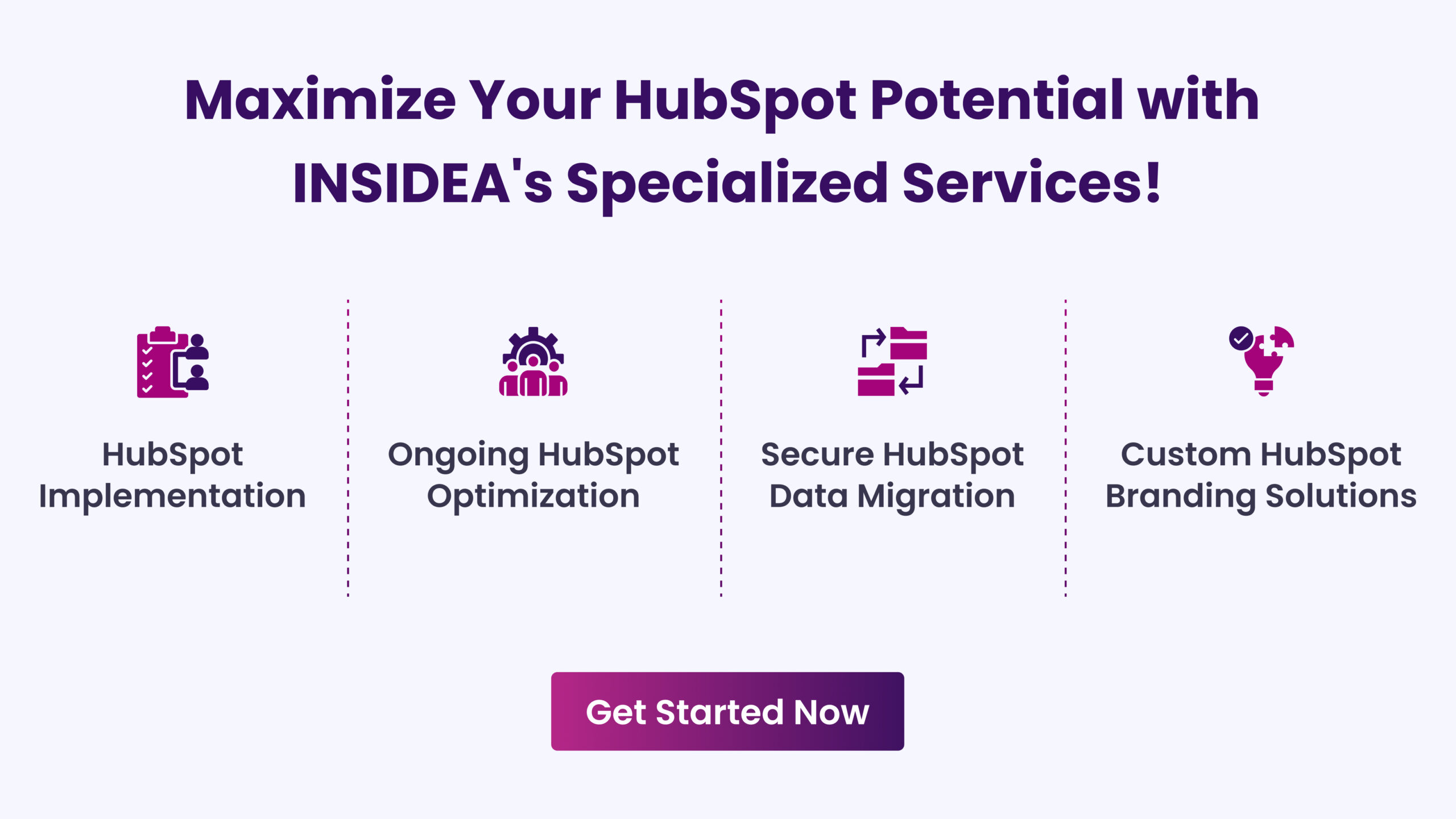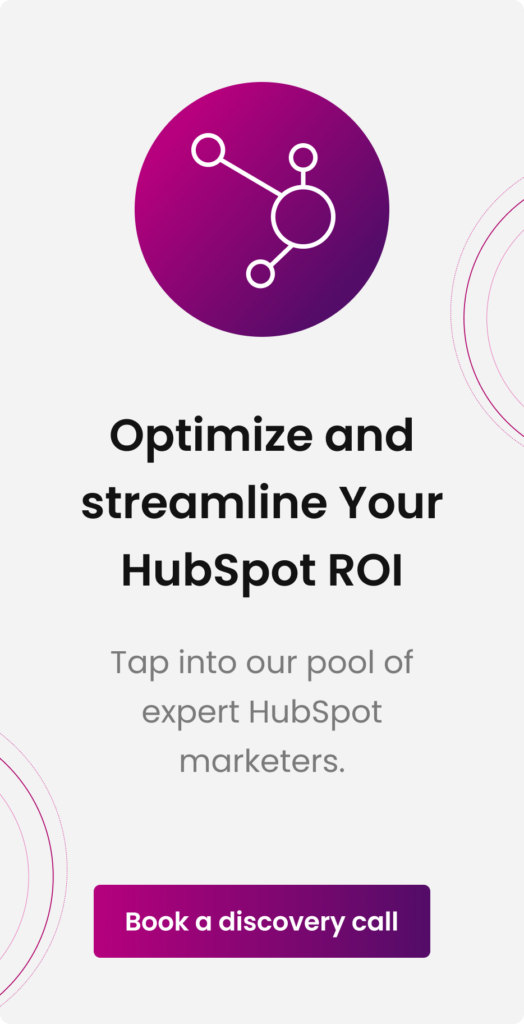Did you know that 42% of marketers lack the tools to analyze their data effectively?
The sheer volume of information from various marketing channels often leaves businesses needing help understanding their performance metrics. Without a centralized system, reviewing campaign success becomes guesswork, leading to missed opportunities and suboptimal strategies.
That’s where HubSpot’s Marketing Analytics and Dashboard Software comes into play. This tool combines all your marketing data into one intuitive dashboard to help you make data-backed decisions that drive growth. With a unified platform, businesses can reduce the time spent manually compiling reports and focus on strategies that matter.
The Main Features of HubSpot’s Marketing Analytics & Dashboard Software
To understand the power of HubSpot’s analytics and dashboard tools, let’s explore some of its key features:
1. Identify Top-Performing Assets Across the Buyer’s Journey
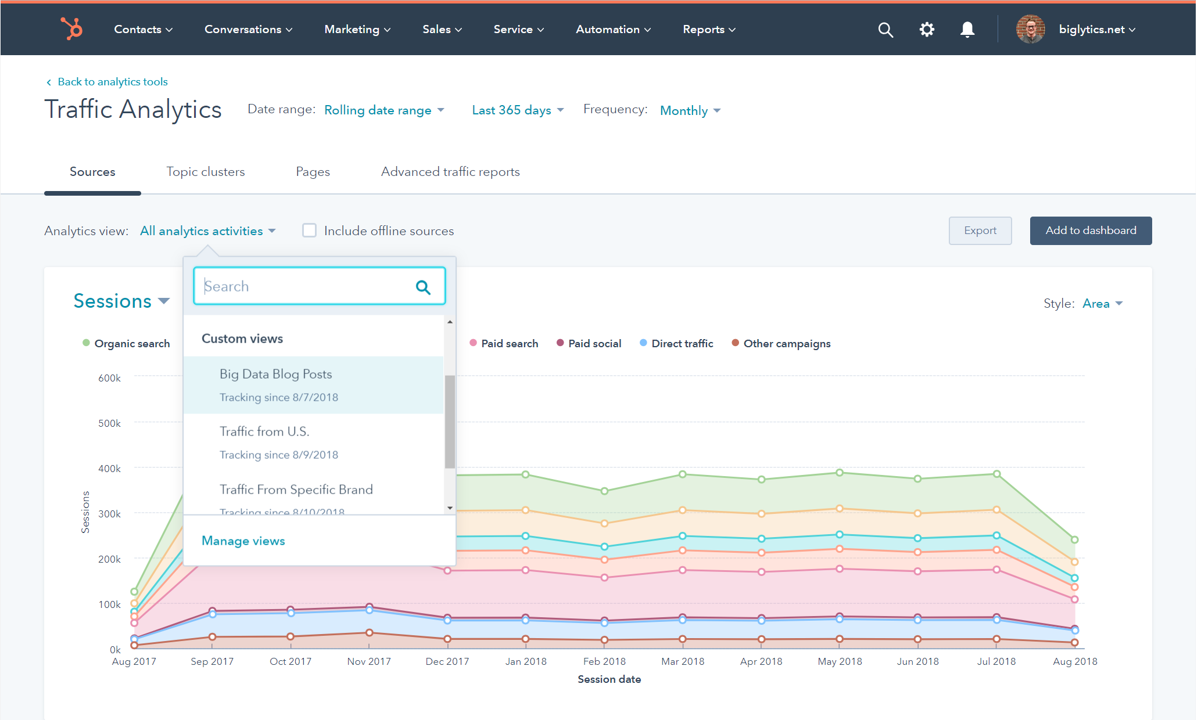
HubSpot allows you to track and analyze the performance of each marketing asset throughout the buyer’s journey. This data lets you pinpoint which touchpoints are most effective in driving conversions and contributing revenue.
Here’s a quick look at how HubSpot helps you assess marketing performance across different stages:
| Stage | Marketing Asset | Performance Metrics |
| Awareness | Blog Posts, Social Media | Traffic, Click-Through Rate (CTR), Shares |
| Consideration | Email Campaigns, Webinars | Open Rate, Engagement, Conversion Rate |
| Decision | Product Demos, Case Studies | Leads Generated, Conversion Rate |
2. Analyze Multi-Channel Campaign Performance
Tracking marketing efforts across multiple channels can be overwhelming. HubSpot simplifies this by consolidating data from email, social media, paid ads, and more into a single dashboard. The multi-touch attribution model lets you see how different touchpoints contribute to conversions, helping you understand the complete customer lifecycle.
3. Track Website Performance Metrics
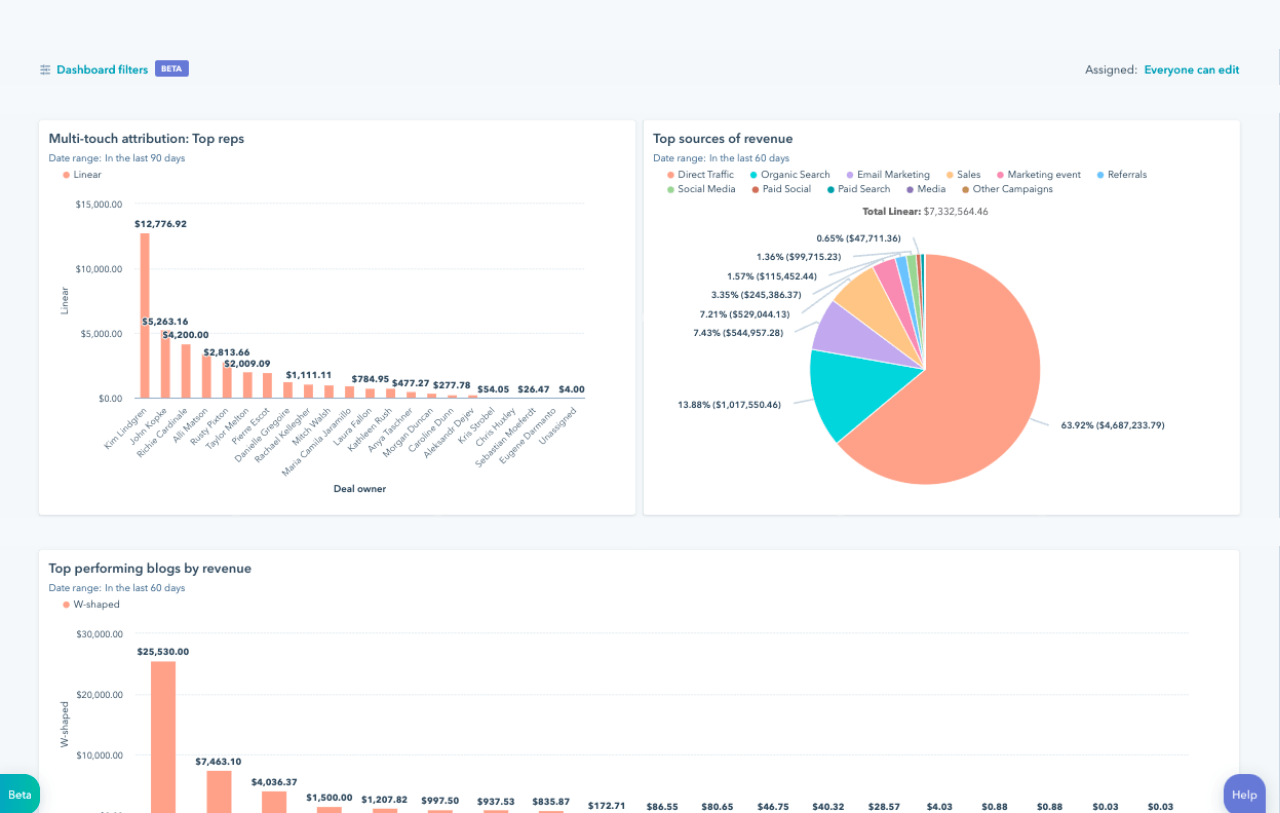
Your website is often the first point of contact for potential customers. Understanding how visitors interact with your site is crucial to delivering a seamless user experience and improving conversion rates. HubSpot’s software lets you track essential metrics like traffic, session duration, bounce rates, and more. With HubSpot’s Website Analytics, you can:
- Measure traffic quality: Compare traffic sources to see which channels drive the most valuable visitors.
- Monitor page performance: Understand how individual pages perform and optimize those with low conversion rates.
- Check visitor behavior: See how users move through your site and where they drop off.
Visualizing this data in real time allows you to refine your website strategy for continuous, better performance.
4. Get Detailed Marketing Reports

You don’t need third-party tools to generate detailed marketing reports with HubSpot. The built-in analytics features offer out-of-the-box reports covering email campaigns to blog posts, landing pages, and social media.
With these features, you can:
- Customize dashboards: Personalize reports based on your specific goals and metrics.
- Track everything in one place: Add any report to your dashboard for a comprehensive performance overview.
- Make data-driven decisions: Use data from past campaigns to inform future strategies.
Sample Marketing Report:
Here’s an example of the types of reports you can generate with HubSpot:
| Report Type | Metrics Included | Use Case |
| Email Campaign Report | Open Rate, CTR, Unsubscribes, Bounce Rate | Optimize email performance |
| Social Media Report | Engagement Rate, Reach, Followers | Track social engagement and growth |
| Lead Generation Report | Leads Captured, Conversion Rate, Sources | Identify high-performing lead
sources |
How to Use HubSpot’s Marketing Analytics & Dashboard Software?
Here’s a step-by-step guide to help you navigate the tool and extract valuable insights for your marketing strategy.
Step 1: Set Up Your Analytics Dashboard
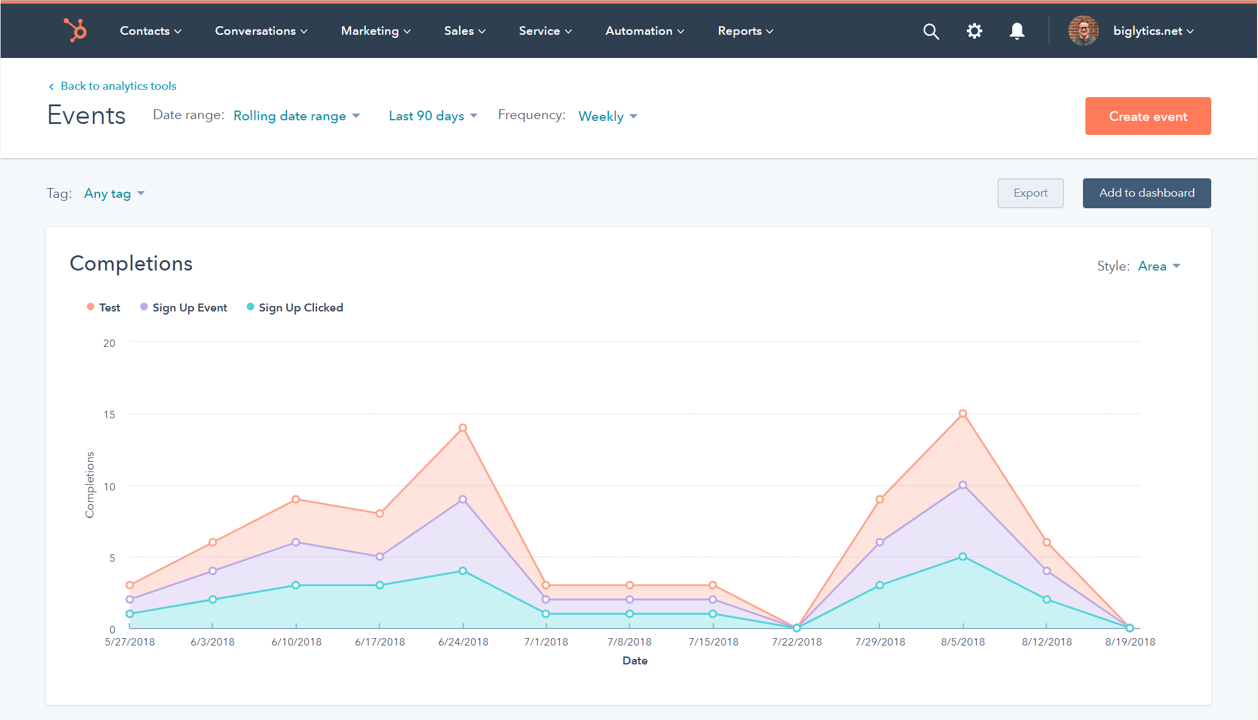
Before getting into the data, you need to configure your analytics dashboard. HubSpot allows you to customize dashboards to suit your needs, whether you want to track overall performance, individual campaigns, or specific metrics.
- Log in to your HubSpot account. In the top menu, navigate to the “Reports” section and click on “Dashboards.”
- Select “Create Dashboard” and choose a template that aligns with your goals (e.g., Marketing Dashboard, Web Analytics, or Custom Reports). You can also build one from scratch to focus on unique metrics.
- Once you set up your dashboard, you can begin adding relevant reports. HubSpot provides pre-built reports that track essential metrics like website traffic, email open rates, social media engagement, and more. You can also create custom reports tailored to specific KPIs.
Step 2: Connect Your Marketing Channels
Connecting all your marketing channels to HubSpot is essential to get a complete view of your marketing performance. This will centralize your data, allowing for cross-channel analysis and reporting.
- Integrate social media accounts. Go to the “Marketing” tab, select “Social,” and connect your Facebook, LinkedIn, Twitter, and Instagram accounts. HubSpot will start pulling in data, including engagement metrics and audience growth.
- Add HubSpot’s tracking code to your website. This allows the tool to collect data on visitor behavior, such as page views, session duration, and conversions. The tracking code is in the “Reports” section under “Tracking Code.”
- If you’re using HubSpot’s email marketing tool, your email performance data (open rates, click-through rates, bounce rates, etc.) will be integrated into your dashboard. If you’re using another email service provider, integrate it with HubSpot to track this data centrally.
Step 3: Track and Analyze Marketing Performance
Once your dashboard is set up and your channels are connected, you can begin tracking key metrics to gauge the effectiveness of your marketing efforts.
- Monitor website traffic and engagement. The “Web Analytics” report tracks total sessions, bounce rates, new vs. returning visitors, and page performance. It lets you see where your traffic is coming from (organic search, social media, email, etc.) and understand how users interact with your site.
- In the “Campaign Analytics” section, check the success of specific campaigns. Track the number of leads generated, the conversion rate, and the ROI for each campaign. Use this data to compare the performance of different campaigns and optimize future strategies.
- One of HubSpot’s standout features is its multi-touch attribution, which helps you understand how different marketing touchpoints contribute to revenue. This allows you to see which actions—like social media posts, email clicks, or blog visits—are most impactful at driving conversions. Go to “Reports” > “Attribution” to explore how marketing efforts influence customer journeys.
Step 4: Create Custom Reports
While HubSpot offers a variety of pre-built reports, you can create custom reports tailored to your business needs. This allows you to focus on specific KPIs unique to your strategy.
- Under the “Reports” tab, select “Reports Builder.” Choose the type of report you want to create, such as a funnel report, a custom bar chart, or an attribution report.
- Select the data points you want to analyze. For example, if you want to analyze email performance, select metrics like “email open rate,” “click-through rate,” and “conversion rate.” You can filter the data by date range, specific campaigns, or traffic sources.
- Once you’ve selected your metrics, HubSpot will automatically generate the report. You can customize the visual format (e.g., bar charts, line graphs, tables) and adjust the data filters to ensure you get the most relevant insights.
Step 5: Schedule Regular Reports
To ensure that your team stays informed on the latest marketing performance, set up automated reports that can be sent to key stakeholders.
- Set up scheduled emails. After creating a report or dashboard, click the “Schedule” button at the top. You can send the report daily, weekly, or monthly to specific team members or external partners.
- Share access to dashboards with different team members based on their roles. For example, the sales team might only need to see lead generation reports, while executives might want an overview of the overall marketing ROI.
Step 6: Optimize Your Campaigns Based on Data
Finally, use the insights from HubSpot’s analytics to optimize your marketing campaigns.
- HubSpot’s A/B testing features allow you to test different elements of your campaigns, such as email subject lines, CTA buttons, or landing page designs. By analyzing the performance of each variation, you can fine-tune your strategy for better results.
- Use the data from your reports to see which channels, content, and strategies drive the most conversions. For example, if your organic search traffic outperforms paid ads, you may want to allocate more of your budget toward SEO efforts.
- Marketing is a dynamic field, and your insights from HubSpot should inform continuous improvement. Regularly revisit your reports to identify new opportunities, trends, and areas for optimization.
How HubSpot’s Marketing Analytics Boost Business Growth?
Using HubSpot’s Marketing Analytics & Dashboard Software offers significant benefits:
- Saves Time and Resources: Automating reporting and centralizing data means fewer hours spent on manual analysis and more time focusing on strategy.
- Improves Decision-Making: With real-time data, you can make smarter, faster decisions backed by solid evidence.
- Boosts Campaign Performance: Continuously optimize campaigns based on what’s working and what isn’t, driving more conversions and better results.
How HubSpot Analytics Integrates with Other Marketing Tools?
To get the most out of HubSpot’s Marketing Analytics and Dashboard Software, it’s important to maximize its features and integration capabilities. Here are some important strategies to help you fully use the platform:
1. Customize Your Dashboards
Tailor your dashboard to focus on the metrics that matter most to your business. HubSpot allows you to add custom reports, filter data by date, and adjust views to zero in on specific KPIs, ensuring that your reports align with your goals.
2. Leverage HubSpot’s Tracking Code
HubSpot’s tracking code provides invaluable insights into user behavior, such as page views, clicks, and form submissions. By analyzing this data, you can create more targeted campaigns and automate workflows based on visitor interactions, improving overall marketing effectiveness.
3. Schedule Regular Reporting
Use HubSpot’s scheduling feature to set up automated reports sent regularly to your team. This ensures everyone stays aligned on the latest performance metrics and allows you to track progress over time, keeping your marketing efforts on track.
4. Integrate HubSpot with Other Marketing Tools
HubSpot integrates seamlessly with tools like Google Analytics, Facebook Ads, LinkedIn, and email marketing platforms, ensuring all your data is centralized. By consolidating data from various channels, you’ll gain a complete view of your marketing ecosystem, making optimizing campaigns and tracking performance easier.
5. Optimize Campaigns with A/B Testing
Use HubSpot’s A/B testing tools to experiment with various elements of your marketing campaigns, such as email subject lines, CTA buttons, and landing page designs. Analyzing the performance of different variations allows you to refine your strategy and achieve better results.
6. Set Up Regular Reports and Automate Workflows
Automation is key to scaling marketing efforts. With HubSpot, you can set up workflows that automatically trigger actions based on user behavior, ensuring that your marketing machine runs smoothly even when you’re not manually monitoring it. This allows your team to focus on strategic improvements rather than repetitive tasks.
Maximize Your HubSpot Potential with INSIDEA’s Specialized Services!
As a HubSpot Diamond Solutions Partner, we take pride in assisting you in streamlining your HubSpot efforts. With our best-in-class marketing, sales, and service solutions, we help you scale exponentially. INSIDEA’s HubSpot Specialists have the required in-depth knowledge and can provide expert guidance on how to use the platform to meet your business needs.
Explore the range of services we offer:
- HubSpot Onboarding: Seamless onboarding process to get your team up to speed and fully integrated with all HubSpot features.
- HubSpot Management: Ongoing management ensures your HubSpot environment runs at peak efficiency.
- HubSpot Migration: Smooth and secure migration services that protect your data and enhance your CRM capabilities.
- HubSpot White-Label Solutions: Exclusive white-label services tailored to your brand, allowing you to offer branded HubSpot solutions.
At INSIDEA, we understand the importance of valuable HubSpot strategies that understand your target audience and drive conversions. Book a meeting with our HubSpot experts to explore how we can help you with your upcoming projects.
Get started now!





